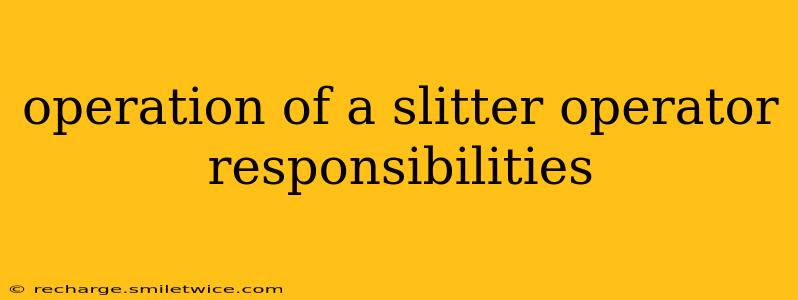A slitter operator plays a crucial role in the manufacturing process, particularly in industries like paper, film, foil, and fabric production. Their responsibilities are multifaceted, demanding both technical skill and a keen eye for detail. This detailed guide explores the core duties of a slitter operator and the skills necessary to excel in this position.
What Does a Slitter Operator Do?
A slitter operator's primary responsibility is to operate and maintain the slitter machine, a crucial piece of equipment that cuts large rolls of material into smaller, specified widths. This process requires precision and attention to detail to ensure the finished product meets quality standards. Beyond the core operation, a skilled slitter operator will be involved in various other aspects of the production line.
Key Responsibilities of a Slitter Operator
-
Setting up and operating the slitter: This involves loading the raw material rolls onto the machine, adjusting the settings (blade placement, tension, speed) according to the specifications of the order, and monitoring the slitting process to ensure accuracy and efficiency.
-
Quality control: Regularly inspecting the slit material for defects such as cuts, tears, wrinkles, and inconsistencies in width. This often involves using measuring tools to verify dimensions and adhering to strict quality control procedures.
-
Maintaining the slitter machine: Performing routine maintenance tasks such as cleaning, lubricating, and replacing worn parts. This proactive maintenance helps prevent breakdowns and ensures the machine's longevity. Operators may also be involved in minor repairs.
-
Troubleshooting and problem-solving: Identifying and resolving issues that arise during the slitting process, such as blade misalignment, material jams, or inconsistencies in the finished product.
-
Record-keeping: Accurately documenting production data, including the number of rolls processed, material specifications, and any quality issues encountered. This is essential for tracking efficiency and identifying areas for improvement.
-
Following safety procedures: Adhering to all safety regulations and guidelines to prevent accidents and injuries. This includes wearing appropriate personal protective equipment (PPE) and following established safety protocols.
-
Working as part of a team: Collaborating effectively with other team members, including machine operators, supervisors, and maintenance personnel, to ensure smooth and efficient production.
What Skills Are Needed to Be a Successful Slitter Operator?
A successful slitter operator requires a blend of technical skills and soft skills.
-
Mechanical aptitude: A strong understanding of mechanical principles and the ability to troubleshoot and repair equipment.
-
Attention to detail: The ability to consistently maintain accuracy and precision throughout the slitting process.
-
Problem-solving skills: The ability to identify and resolve issues quickly and efficiently.
-
Ability to work independently and as part of a team: Successfully managing solo tasks while also being a collaborative team player.
-
Physical stamina: The job can be physically demanding, requiring prolonged standing, lifting, and bending.
-
Basic computer skills: For record-keeping and data entry.
H2: What is the difference between a slitter and a rewinder?
While both machines are crucial in the converting process, they serve distinct purposes. A slitter cuts a wide roll of material into narrower rolls, whereas a rewinder rewinds the slit material onto new cores. Often, they work in tandem—the slitter cuts the material, and the rewinder prepares it for packaging and shipment.
H2: What are the safety precautions when operating a slitter?
Safety is paramount when operating a slitter. Precautions include wearing appropriate PPE (safety glasses, gloves, hearing protection), ensuring the machine is properly guarded, and following lockout/tagout procedures during maintenance. Training on safe operating procedures is crucial.
H2: How much does a slitter operator earn?
Slitter operator salaries vary based on location, experience, and company. Researching average salaries in your area through job boards and salary websites is recommended.
H2: What are the career advancement opportunities for a slitter operator?
Experienced slitter operators can progress to supervisory roles, such as shift supervisor or team lead. They might also specialize in more complex slitting processes or move into maintenance and repair positions.
By combining a strong understanding of the machine’s operation with a commitment to safety and quality, a slitter operator plays a vital role in ensuring the smooth and efficient production of countless products we use every day.
